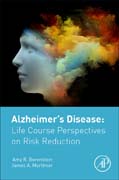
Alzheimers Disease: Life Course Perspectives on Risk Reduction
Borenstein, Amy
Mortimer, James
Alzheimer's Disease: Lifecourse Perspectives on Risk Reduction summarizes the growing body of knowledge on the distribution and causes of Alzheimer's disease (AD) in human populations, providing the reader with knowledge on how we define the disease and what its risk and protective factors are in the context of a life-course approach. At the conclusion of the book, the reader will understand why Alzheimer's disease likely begins at conception, then progresses through early-life and adult risk factors that ultimately impact the balance between pathologic insults in the brain and the ability of the brain to modify disease symptoms. In contrast to edited volumes that may have little cohesion, this book focuses on an integrated life-course approach to the epidemiology of dementia, in particular, Alzheimer's disease. Reviews the current science surrounding Alzheimer's diseaseProvides a primer of foundational knowledge on the disease's epidemiology and biostatisticsUtilizes a life-course approach, providing a novel and integrated view of the evolution of this illness from genes to brain reserveUses the 'threshold model'-a theory first described by Dr. Mortimer and widely accepted today-which incorporates the idea of risk factors for the pathology and expression of the disease Proposes that improving brain health through modifiable behaviors can delay disease onset until a later ageExamines the future of prevention of Alzheimer's disease, a subject of great current interest INDICE: Prologue: A Primer on Epidemiologic Concepts Section 1. Definition of a Case Chapter 1. Dr. Alois Alzheimer defines the first case Chapter 2. Biology of a Case Chapter 3. Clinical appearance and progression Chapter 4. Neuropathology Chapter 5. The threshold model of dementia Section 2. Descriptive Epidemiology Chapter 6. Prevalence of AD Chapter 7. Incidence of AD Chapter 8. Survival and Mortality Section 3. Analytic Epidemiology Chapter 9. Risk Factors for AD Pathology vs. Disease Expression Chapter 10. Genetics, Down Syndrome and Family History Chapter 11. Early-Life Factors Chapter 12. Head Trauma Chapter 13. Tobacco and Alcohol Consumption Chapter 14. Vascular disease: diabetes, hypertension and white matter disease Chapter 15. Diet Chapter 16. Physical Activity Chapter 17. Social Engagement Chapter 18. Mental Activity Chapter 19. Medications: Non-Steroidal Anti-Inflammatory Drugs (NSAIDs), Statins, Hormone Replacement Therapy Section 4. Epidemiologic and Biologic Markers Chapter 20. Prodromal Markers of Disease or Epidemiologic Risk Factors? The Examples of Depression, Olfaction, Subjective Memory Impairment Chapter 21. Biologic Markers of Early Detection Section 5. Future Steps Chapter 22. Prevention of AD Chapter 23. Risk Assessment and Personalized Prevention: the Path to the Future?
- ISBN: 978-0-12-804538-1
- Editorial: Academic Press
- Encuadernacion: Cartoné
- Páginas: 470
- Fecha Publicación: 01/02/2016
- Nº Volúmenes: 1
- Idioma: Inglés
